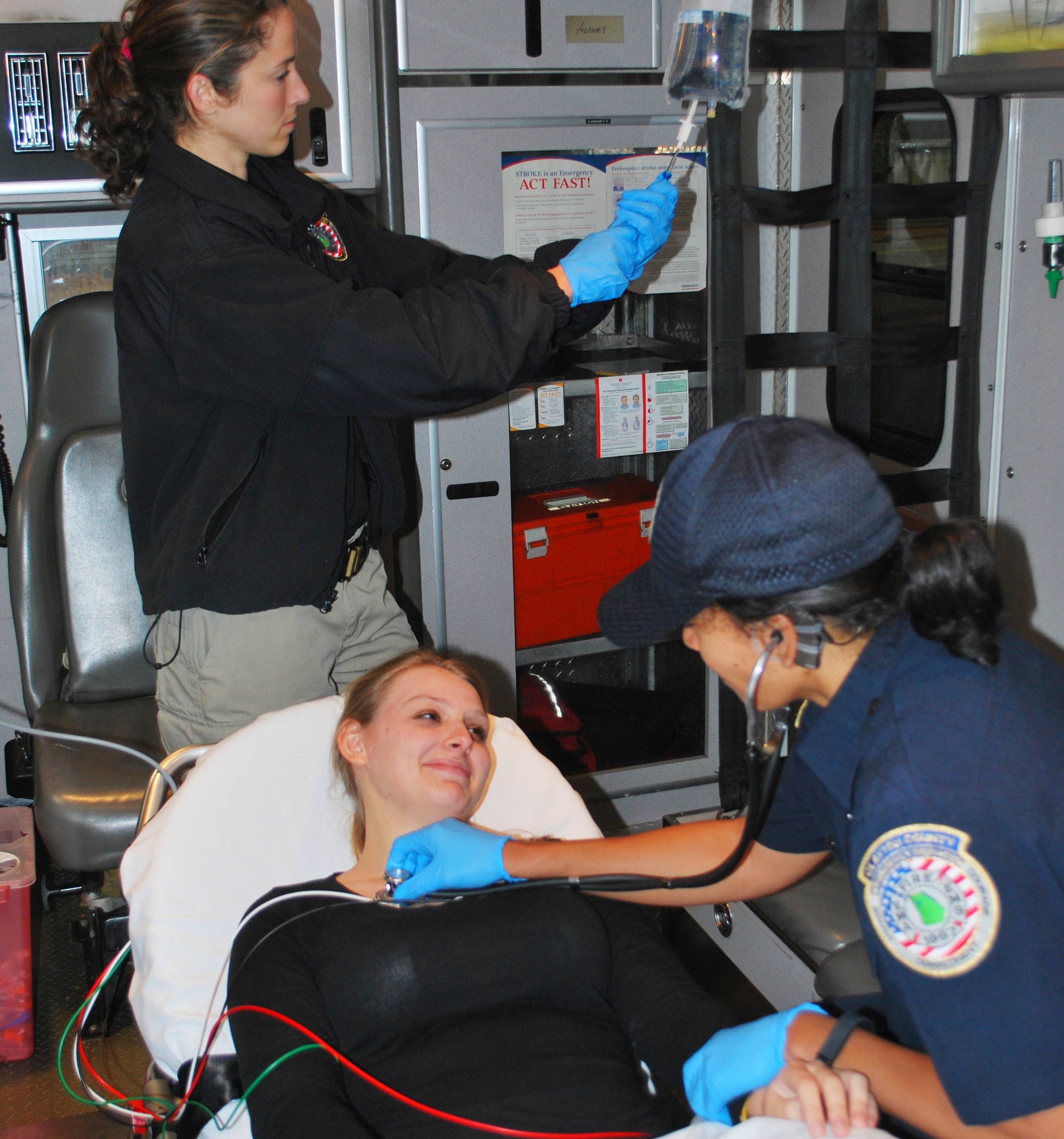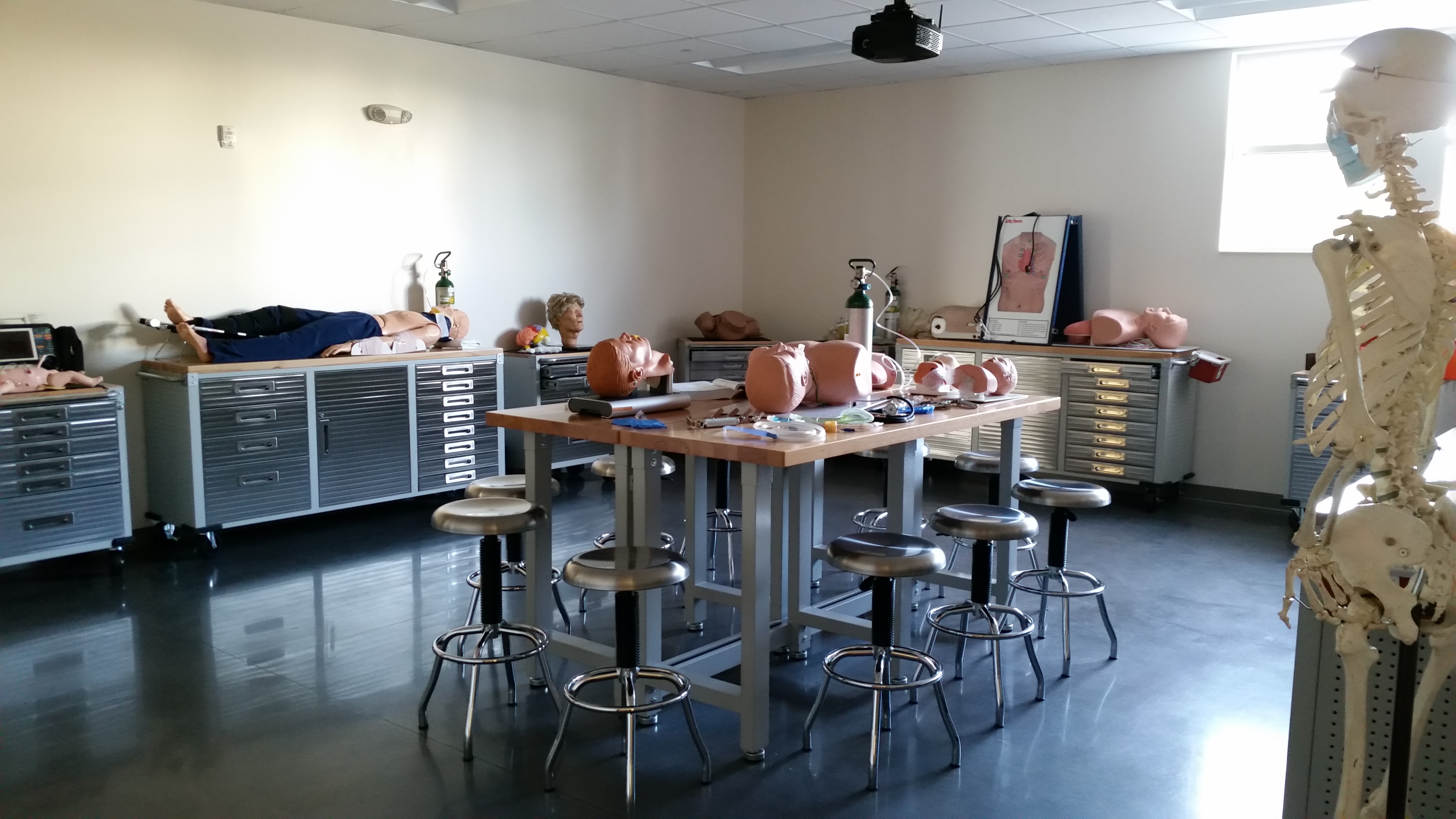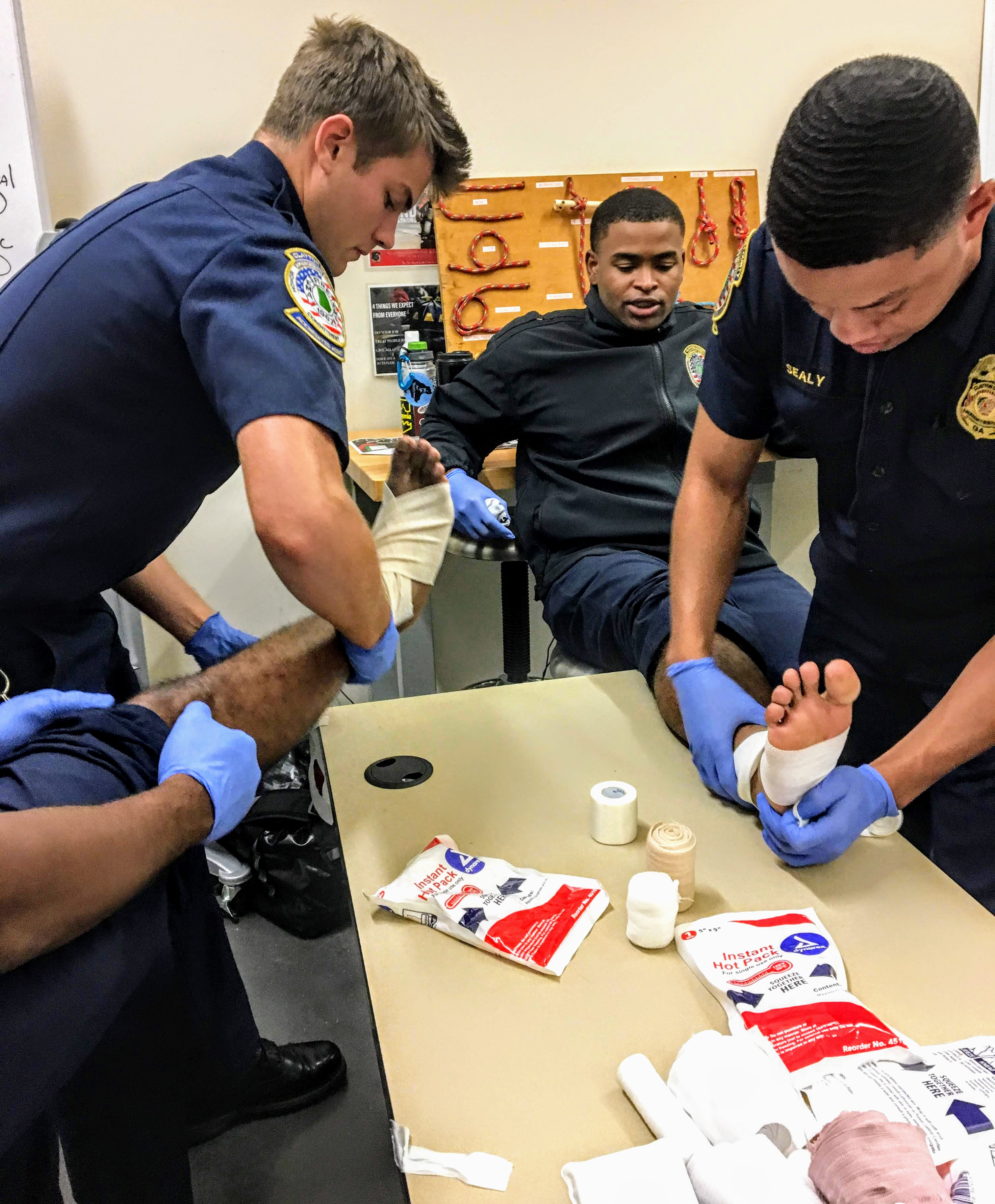Course Description: Paramedic Program
CCFES Paramedic Program
The Commission on Accreditation of Allied Health Education Programs (CAAHEP) accredits programs upon the recommendation of the Committee on Accreditation of Educational Programs for the Emergency Medical Services Professions (CoAEMSP). Clayton County Fire & Emergency Services is a CAAHEP approved paramedic program since 2016. For further information, you may contact the agencies at the bottom of this page.
PROGRAM MISSION STATEMENT

Our mission is to provide a sequence of courses that prepares qualified individuals to enter the paramedic profession with the knowledge, critical thinking abilities, attitudes and advanced life support skills needed for professional entry-level competence, patient advocacy and continued educational growth throughout their career as a healthcare provider. We will provide a learning environment that promotes program completion, graduation and success after graduation, whether in employment or further higher education.
WELCOME
On behalf of Clayton County Fire & Emergency Services (CCFES), welcome to our training academy for paramedic instruction.
Our training and educational programs are designed to provide an economical, long-standing learning opportunity for students with an interest in becoming certified or licensed professionals. Training academy programs will enable students to obtain the knowledge, skills, and proper professional attitude necessary to succeed in the field of fire and emergency medical services (EMS). Many of our programs are designed to support agency training needs through careful analysis of the most current continuous quality improvement (CQI) data, national and state requirements such as recertification courses, and requested educational classes from our line personnel. The training staff is here to provide services that encourage and stimulate competency, innovation, and increased effectiveness.
 The online program layouts are available to assist in your transition from the training academy to an emergency medical profession and/or a fire related field by providing an overview of our programs and the policies and procedures of Clayton County Fire & Emergency Services training academy. The materials and resources within this program as well as those used throughout the course modules are evaluated on a continuous basis and reflect current practices. They are reviewed and updated annually to ensure performance indicators are met. All students currently enrolled in a program are subject to any revisions and changes within the training academy manual.
The online program layouts are available to assist in your transition from the training academy to an emergency medical profession and/or a fire related field by providing an overview of our programs and the policies and procedures of Clayton County Fire & Emergency Services training academy. The materials and resources within this program as well as those used throughout the course modules are evaluated on a continuous basis and reflect current practices. They are reviewed and updated annually to ensure performance indicators are met. All students currently enrolled in a program are subject to any revisions and changes within the training academy manual.
There is a multitude of department, academy, state, and national policies and procedures that must be adhered to in order to be successful as a paramedic student. If you have any questions regarding policies, contact your instructor or any of our technically proficient support staff for further assistance.
Clayton County Fire & Emergency Services is currently accredited as a paramedic program. This not only identifies and creates a mechanism for developing strategic and program action plans to address deficiencies within the organization, but also ensures your continued access to the National Registry EMS examination process and enhances your mobility (i.e., reciprocity) among states as an EMS provider.
The training academy staff wishes you success as a student with the Clayton County Fire & Emergency Services training academy, as well as in your career as a future public safety professional.
Sincerely,
Clayton County Training Academy Staff
INTRODUCTION

A paramedic is an allied health professional whose primary focus is to provide advanced emergency medical care for critical and emergent patients who access the emergency medical system. This individual possesses the complex knowledge and skills necessary to provide patient care and transportation. Paramedics function as part of a comprehensive EMS response, under medical oversight. Paramedics perform interventions with the basic and advanced equipment typically found on an ambulance. The paramedic is an essential link from the scene into the health care system.
Today’s paramedics are professional health care clinicians and practitioners of emergency field medicine. The present paramedic curriculum provides both a broad-based medical education and a specific intensive training program designed to prepare the student to perform the traditional role as providers of emergency field medicine. It also provides a broad foundation in anatomy and physiology, patient assessment, pathophysiology of disease, and pharmacology that allows students to expand their roles in the health care industry. Our paramedic program is intended to produce graduates who are prepared for employment in paramedic positions in today's health services field.
Our program provides learning opportunities that introduce, develop, and reinforce academic and occupational knowledge, skills, and attitudes required for job acquisition, retention, and advancement. Program graduates are to be competent in the general areas of: communications, math, and basic computer skills, as well as, competent in the occupational areas of: anatomy and physiology, pathophysiology, medical terminology, operations, patient assessment, pharmacology, advanced airway skills, cardiology, trauma, medical emergencies, gynecology, obstetrics, pediatrics, geriatrics, special patient needs, critical thinking, assessment/evidence based patient care, and therapeutic communication.
Successful completion of the program allows the graduate to challenge the National Registry of Emergency Medical Technicians Paramedic certification examination and apply for Georgia licensure as a paramedic as set forth by the Office of Emergency Medical Services and Trauma.
COURSE OBJECTIVES
The Paramedic program will:
- Provide current curriculum, instructional materials, and equipment (in accordance with available funding), which teach knowledge (cognitive), skills (psychomotor), and attitudes (affective) learning domains appropriate to industry needs.
- Provide educational facilities, which foster learning and provide safe, healthy environments available and accessible to all students who can benefit from the program.
- Provide an educational atmosphere, which promotes a positive self-image and a sense of personal well-being.
- Provide an educational environment that encourages students to maintain their own physical and emotional health.
- Provide education that fosters the development of good safety habits. Provide information to the public regarding the program that will facilitate recruitment and enrollment of students.
- Promote good public relations via contacts and regular communications with businesses, industries, and the private sector.
- Promote faculty and student rapport; facilitate communications to enhance student success in the program.
- Prepare graduates to function within the definition and framework of their role specified by the EMT Oath.
- Provide academic instruction, which supports effective learning within the program, which enhances professional performance on the job.
- Provide employment skills, which foster positive work ethics that will enable graduates to perform as exceptional employees.
- Facilitate academic achievement and encourage students to pursue continuing education as a lifelong goal.
- Provide admission, educational, and placement service without regard to race, color, national origin, religion, sex, age, handicapping condition, academic disadvantage, economic disadvantage, or sexual orientation (except in those special circumstances permitted or mandated by law).
The graduates of the paramedic program will be able to:
- Demonstrate competent entry-level abilities in the cognitive (knowledge), psychomotor (skills), and affective (behavior) learning domains of the Paramedic Program.
- Demonstrate responsibility and accountability for ethical, legal, and professional standards within the guidelines of the Paramedic practice.
- Integrate knowledge of scientific, behavioral and cultural principles to provide client-centered care to individuals with complex needs.
- Demonstrate the ability to perform a comprehensive assessment on pediatric, adult, and geriatric patients.
- Demonstrate the ability to perform a comprehensive assessment on an obstetric, medical, trauma, and psychiatric patient.
- Demonstrate the ability to serve as team leader in a variety of pre-hospital emergency situations.
- Provide clinically competent care to culturally diverse clients utilizing evidence-based practice, critical thinking and decision-making within the framework of the pre-hospital care process.
- Utilize therapeutic communication skills to effectively interact with the individual, family, significant support person(s), and other members of the health care team.
- Value the importance of lifelong learning and professional development.
ADVANCED PLACEMENT
CCPSTA's articulation agreement with Southern Crescent Technical College (SCTC) is designed to encourage students to continue their educational pursuits in the EMS profession. Our paramedic course syllabus is comparable to the Paramedicine coursework of SCTC, with the exception of the additional electives. Any paramedic student wishing to advance his/her certification to a degree may apply to SCTC and transfer CCPSTA paramedic courses for credit toward an Associate of Applied Science in Paramedicine.
CCPSTA may recognize previous post-secondary course work by accepting credits that were earned from another educational system or from regionally accredited colleges, if they can be verified as equivalent to specific course work. To challenge a course requirement curing the paramedic course, a student will need to "test out" of the subject matter with an 80% or better on the equivalency exam. This may allow the student to receive advanced placement in the course.

Students who have previously taken an EMS course within the Paramedic curriculum (as evidenced by transcripts) may be allowed one attempt to clep that course. The student must challenge a version of the course final exam no less than two weeks prior to the start of that EMS course. The student must score an 80% or better to be allowed to clep that EMS course. If the student does achieve the appropriate score, their grade will be figured based on the courses remaining in that semester. Students are allowed to clep no more than three EMS courses.
FACULTY RECRUTIMENT
Clayton County is an equal opportunity employer and promotes diversity in our workplace and does not make employment-related decisions based on race, color, religion, sex, national origin, disability, or any other discriminatory factors.
To view a list of current Training Division employment opportunities please click here
ACADEMIC CALENDAR
Clayton County Fire and Emergency Services offers enrollment into our paramedic program twice a year. Enrollment for the paramedic program is offered in the Spring and Fall terms. Schedules vary and are subject to change at any time.
If interested please contact Captain Jeremy Menzel at jeremy.menzel@claytoncountyga.gov and then click here to fill out the interest form.
PROGRAM COST
The total cost of tuition for the fifteen (12) month paramedic program is $5,000.00. Books and any additional supplies are separate. Payment plans are available. Contact the Training Division for more information.
PARAMEDIC OUTCOMES
2022 Program Outcomes:


Retention: 77.4%
Job Placement: 100%
NOTE: No graduates during the 2021 reporting year
NOTE: No graduates during the 2020 reporting year
2019 Program Outcomes
Retention 81%
Positive Job Placement 100%
CAAHEP
P:727-210-2350
F:727-210-2354
E: mail@caahep.org
COAEMSP
8301 Lakeview Parkway, Suite 111-312, Rowlett, TX 75088Phone: 214.703.8445
Fax: 214.703.8992